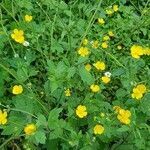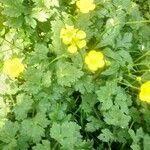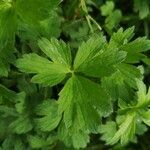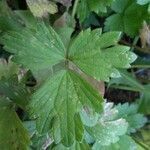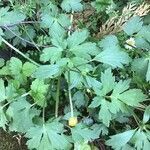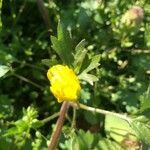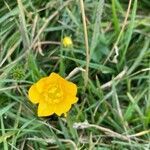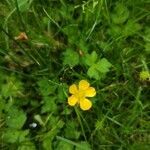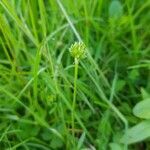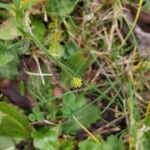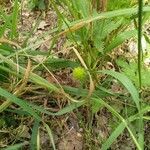Herbs perennial. Stolons present. Stems ascending or suberect, 10--60 cm, subglabrous or sparsely puberulent, branched above. Basal leaves with petiole 7--20 cm; blade ternate, 3-partite, rarely 3-sect, central leaflet broadly rhombic, 2--4.2 × 1.8--3.8 cm, glabrous or adaxially appressed puberulent, base broadly cuneate, secondary lobes lobed or more deeply divided; lateral leaflets oblique, unequally 2-or 3-lobed or-partite. Stem leaves similar to basal ones, smaller and shortly petiolate upward. Monochasium terminal, 2-to several flowered; bracts 3-sect or undivided, lanceolate-linear. Flowers 1.5--2.2 cm in diam. Pedicel 1--8 cm, appressed puberulent. Receptacle puberulent. Sepals 5, elliptic-ovate, 5--7 mm, abaxially appressed pubescent or subglabrous. Petals 5 (7--22 in f. polypetalus), obovate, 7--10 × 5--7 mm, nectary pit covered by a scale, apex rounded or rounded-truncate. Stamens numerous; anthers oblong. Aggregate fruit ovoid, 5--7 mm in diam.; carpels numerous. Achene bilaterally compressed, obliquely obovate, 2.2--3 × 1.8--2.1 mm, glabrous, narrowly marginate; style persistent, 0.5--0.8 mm. Fl. Apr--Aug, fr. May--Aug.
Stoloniferous perennial; roots fibrous; stolons robust, mostly above ground, rooting at nodes. Basal leaves very variable; petiole 2–35 cm long; lamina triangular-ovate, 2–15 cm long, trifoliolate; leaflets ± petiolulate, broadly ovate, entire and irregularly toothed, or further ± ternately (sometimes ± biternately) dissected, subsericeous, pilose or ± glabrous. Uppermost stem-leaves sessile, linear-lanceolate, entire. Flowering stems 1–3 (–5)-flowered, 15–75 cm high, pilose to subsericeous. Sepals 5, appressed or spreading, ovate to broad-elliptic, 5–8 mm long, pubescent below. Petals usually 5, broadly obovate, 6–15 mm long, 5–10 mm wide, yellow, glossy; nectary near petal-base, with lobe obovate to cuneate, 1–2 mm long, free for most of this length. Stamens 35–75. Pistils c. 20–50. Receptacle hispid. Achenes ± orbicular, 2.5–3.5 mm long, strongly laterally compressed, glabrous, finely punctulate, distinctly margined; beak c. 1 mm long, straight or curved.
Perennial; roots all fibrous. Stems stoloniferous, ± slender, arising from compact rootstock, arcuately decumbent and rooting at nodes, hairy, 30-60-(100) cm long. Lvs with sparse to dense hairs, 3-foliolate, at least the middle segment stipitate; basal lvs ovate-deltoid, 2-4-(7) × 2-5-(8) cm; leaflets deltoid, 3-lobed, dentate; petioles glabrous to hairy, (2)-5-15-(25) cm long. Upper cauline lvs similar to basal; leaflets becoming linear-lanceolate, entire. Fls 1-3-(10) per stem, (15)-20-25-(30) mm diam. Pedicels erect, with appressed hairs, sulcate, 3-10-(20) cm long. Sepals 5, hairy, spreading, 6-8 mm long. Petals 5, yellow, obovate, (9)-10-12 × 7-9 mm; nectary single, 0.5 mm from petal base, covered by a broad, obtuse or emarginate scale. Receptacle hairy. Achenes 20-40, glabrous, strongly flattened, bordered, broadly obovate; body 2-3 × 2-2.5 mm; face smooth; beak hooked at tip, 1-1.5 mm long.
Stems decumbent or creeping, rooting nodally, hispid to strigose or almost glabrous, base not bulbous. Roots never tuberous. Basal leaf blades ovate to reniform in outline, 3-foliolate, 1-8.5 × 1.5-10 cm, leaflets lobed, parted, or parted and again lobed, ultimate segments obovate to elliptic or sometimes narrowly oblong, margins toothed, apex obtuse to acuminate. Flowers: receptacle hispid or rarely glabrous; sepals spreading or reflexed from base, 4-7(-10) × 1.5-3(-4) mm, hispid or sometimes glabrous; petals 5(-150), yellow, 6-18 × 5-12 mm. Heads of achenes globose or ovoid, 5-10 × 5-8 mm; achenes 2.6-3.2 × 2-2.8 mm, glabrous, margin forming narrow rib 0.1-0.2 mm wide; beak persistent, lanceolate to lance-filiform, curved, 0.8-1.2 mm. 2 n = 14, 32.
Hirsute to strigose or subglabrous perennial, mostly creeping, rarely ascending or erect; lvs petioled, 3-parted, the terminal segment stalked, all segments broadly obovate to subrotund, cleft or lobed, sharply toothed; pet 8–15 mm, two-thirds as wide; anthers 1–2 mm; achenes broadly and obliquely ovate, 2.5–3.5 mm, sharply but narrowly margined, the beak triangular, usually curved, 0.8–1.5 mm; 2n mostly =32. Native of Europe, naturalized in fields, lawns, roadsides, and wet meadows. May–July. Robust, subglabrate plants have been called var. glabratus DC., and double-flowered ones have been called var. degeneratus Schur or var. pleniflorus Fernald.
A small herb which keeps growing from year to year. It grows 10-60 cm high. It has creeping runners or stolons. These form roots at the nodes. The leaf is made up of 3 leaflets. These are triangle shaped and 2-13 cm long. The leaflets are usually divided into 3 lobes. These have teeth along the edge. The flowers are yellow. They are 2-3 cm across. The petals are smooth and shiny. There are 5 petals and 5 spreading and hairy sepals. The fruit are dry and 2-3 mm long. The edges have ridges.

